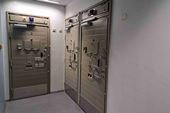In many companies’ access systems, only the most important doors and locks are wired to mains electricity. Software then filters and monitors traffic. It is a tried-and-trusted way to let the right people in — and keep everyone else out.
Yet, according to Assa Abloy, the expense and disruption of wiring doors can stop electronic access control in its tracks at the front entrance. This leaves building door control in the hands of mechanical locking, which limits the flexibility and control of security, and its potential contribution to business success.
The answer says the access control specialist "is to unleash access control from its cables." Extending security with wireless devices — managing access around a building interior — can benefit a business in at least three different ways, as Assa Abloy describes here.
Only authorised personnel can open sensitive doors
Not everyone should be able to walk into the CEO’s office or open the server room. In real-world situations, where staff are busy, relying on manual lock-and-key technology often leaves doors unguarded. If a lock is somehow breached, a security manager will have no idea when, nor will they be able to identify the last person to open the door.
Cable-free electronic locking devices are available for all kinds of internal door, of every size and any material. At Luminy University in France, for example, wireless devices ensure only qualified and authorised staff open rooms where hazardous materials are stored. They are controlled and monitored from the same system as the university’s wired doors.
Businesses can filter and track access to more than just rooms, too. Wireless cabinet locks add security to cupboards, cabinets and drawers — for employee personal items, controlled medicines or almost anything else. A wired system may find it difficult to reach these openings.
Battery-powered locks can add real-time control and monitoring to server racks, so IT staff know right away if unauthorised access has even been attempted. Assa Abloy's findings show that with the cost of a typical data breach estimated at $4.24m (€3.7m), an investment in wireless Aperio server rack locking could repay itself many times over.
Convenience and peace of mind
Wireless devices can bring access control much deeper into a building. Employees feel safer at work; facilities and security managers can relax, because important openings beyond the front door are secured and monitored, without any time wasted tracking bunches (or hundreds) of physical keys.
The workload to maintain a network of wireless devices is minimal. For example, Aperio wireless locks only need a change of battery every two years on average, nothing more.
Battery operation is energy — and therefore, cost — efficient, too. Compared to traditional wired locking, wireless devices contribute to an energy-efficiency strategy: Installation is less invasive and less energy intensive; it uses fewer materials like cabling.
For visitors and employees, a single credential still opens all their authorised locks. No one carries large, inconvenient key bunches or wastes time hunting for the right key.
Understand building use... and users
With the exception of designated “high security doors”, wired access control often stops at the front entrance. Once employees and visitors are inside the building, the system loses track of them. This leaves valuable business data un-gathered.
Extending access control with wireless digital devices can help collect this data and put it to work. Technology protocols and standards such as OSDP and LDAP ensure the data is interoperable with complementary systems, now and in the future.
For example, a better understanding of building use enables more efficient energy management. If no one is occupying a suite of offices, why heat or air-condition them? Data from a more comprehensive access system could help automated systems make intelligent, cost-saving decisions in real time.
Granular access control can also help inform decisions about leasing office space — and of what type — or whether to let leases expire. This type of data will only grow in importance as work patterns become fluid. IBM's latest research estimates the global mobile workforce will soon number 1.87 billion people, so, understanding how these workers use space will be critical — and could directly influence business success.

















